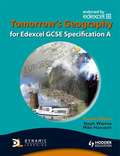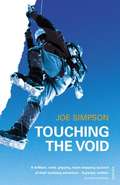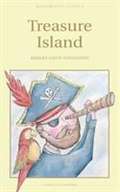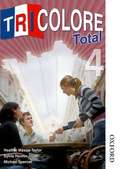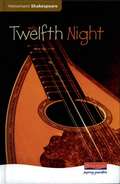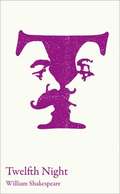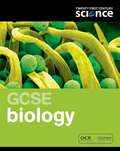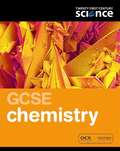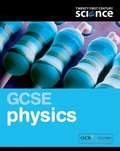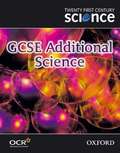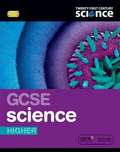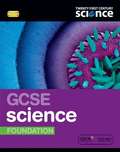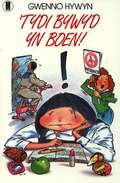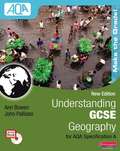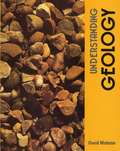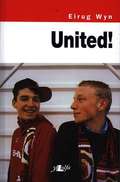- Table View
- List View
Tomorrow's Geography for Edexcel GCSE Specification A (PDF)
by Steph Warren Mike HarcourtEndorsed by Edexcel, this brand new edition of a best selling title is designed to prepare your students for exam success for the latest Edexcel A specification. Covers all four units of the specification, including comprehensive coverage of Unit 1 Geographical Skills and Challenges for the Planet, all the content for Units 2 and 3, and Controlled Assessment for Unit 4.
Touching the Void
by Joe SimpsonTouching theVoid is the heart-stopping account of Joe Simpson's terrifying adventure in the Peruvian Andes. He and his climbing partner, Simon, reached the the summit of the remote Siula Grande in June 1995.
Translation
by RnibThis diagram shows three triangles; the original triangle and its translation in two different ways to two new positions. A locator dot and title are shown. These must always be at the top left of the page when the image is the right way up. There is a graph with all four quadrants showing, and the x and y axes ranging from -3 to 3. The x and the y axes intersect at the origin marked by an O. Axes values are positive to the right and to the top of the diagram. Axes values are negative to the left and to the bottom of the diagram. Not all axis division marks are labelled. Some of the braille uses maths code notation. When a shape is translated, it stays the same shape and orientation; only its position changes. The original triangle is in the top left quadrant. There is a translation to the right of a value of 4, and then a translation down of a value of 1. There is also a second translation, right to a value of 4, and then down to a value of 4. The movement of the first triangle is indicated by a heavy dashed line.
Translation
This diagram shows three triangles; the original triangle and its translation in two different ways to two new positions. A locator dot and title are shown. These must always be at the top left of the page when the image is the right way up. There is a graph with all four quadrants showing, and the x and y axes ranging from -3 to 3. The x and the y axes intersect at the origin marked by an O. Axes values are positive to the right and to the top of the diagram. Axes values are negative to the left and to the bottom of the diagram. Not all axis division marks are labelled. Some of the braille uses maths code notation. When a shape is translated, it stays the same shape and orientation; only its position changes. The original triangle is in the top left quadrant. There is a translation to the right of a value of 4, and then a translation down of a value of 1. There is also a second translation, right to a value of 4, and then down to a value of 4. The movement of the first triangle is indicated by a heavy dashed line.
Translation
This diagram shows three triangles; the original triangle and its translation in two different ways to two new positions. A locator dot and title are shown. These must always be at the top left of the page when the image is the right way up. There is a graph with all four quadrants showing, and the x and y axes ranging from -3 to 3. The x and the y axes intersect at the origin marked by an O. Axes values are positive to the right and to the top of the diagram. Axes values are negative to the left and to the bottom of the diagram. Not all axis division marks are labelled. Some of the braille uses maths code notation. When a shape is translated, it stays the same shape and orientation; only its position changes. The original triangle is in the top left quadrant. There is a translation to the right of a value of 4, and then a translation down of a value of 1. There is also a second translation, right to a value of 4, and then down to a value of 4. The movement of the first triangle is indicated by a heavy dashed line.
Treasure Island (PDF)
by Robert Louis Stevenson'Fifteen men on the dead man's chest-Yo-ho-ho and a bottle of rum!' Treasure Island is a tale of pirates and villains, maps, treasure and shipwreck, and is perhaps the best adventure story ever written.
Tricolore Total 4: Student Book (PDF)
by Mascie-Taylor, Heather|Honnor, Sylvia|Spencer, MichaelThe fourth stage in the new edition of this tried and trusted course has been updated to meet the requirements of the new GCSE specifications, providing a range of blended resources to help support and develop independent learning and creativity.
Turning forces (large print)
by Rnib BookshareThis diagram shows turning forces acting on an open-ended wrench in the middle of the page with the head of a nut in its jaws. There is a locator dot shown, which will be at the top left of the page when the image is the right way up. The handle of the wrench is to the left centre of the page. The jaws are to the right. The six-sided head of the nut fits into the jaws of the wrench, with a dot at its centre that marks its fulcrum (pivot point). To the right of the nut is an arrow showing the anti-clockwise direction of turning. Down the page from the left of the wrench is an arrow pointing down, showing the direction of force and a label showing the force in Newtons. Further down, running horizontally, is a dimension line that shows the distance from the end of the handle to the pivot point.
Turning forces (UEB contracted)
by Rnib BookshareThis diagram shows turning forces acting on an open-ended wrench in the middle of the page with the head of a nut in its jaws. There is a locator dot shown, which will be at the top left of the page when the image is the right way up. The handle of the wrench is to the left centre of the page. The jaws are to the right. The six-sided head of the nut fits into the jaws of the wrench, with a dot at its centre that marks its fulcrum (pivot point). To the right of the nut is an arrow showing the anti-clockwise direction of turning. Down the page from the left of the wrench is an arrow pointing down, showing the direction of force and a label showing the force in Newtons. Further down, running horizontally, is a dimension line that shows the distance from the end of the handle to the pivot point.
Turning forces (UEB uncontracted)
by Rnib BookshareThis diagram shows turning forces acting on an open-ended wrench in the middle of the page with the head of a nut in its jaws. There is a locator dot shown, which will be at the top left of the page when the image is the right way up. The handle of the wrench is to the left centre of the page. The jaws are to the right. The six-sided head of the nut fits into the jaws of the wrench, with a dot at its centre that marks its fulcrum (pivot point). To the right of the nut is an arrow showing the anti-clockwise direction of turning. Down the page from the left of the wrench is an arrow pointing down, showing the direction of force and a label showing the force in Newtons. Further down, running horizontally, is a dimension line that shows the distance from the end of the handle to the pivot point.
The Twelfth Night
by John Seely William ShakespeareThe gentle melancholy and lyrical atmosphere of Twelfth Night have long made the play a favourite with Shakespearian audiences. The plot revolves around mistaken identities and unrequited love, but is further enlivened by a comic sub-plot of considerable accomplishment. In it, Sir Toby Belch and his companion outwit the pretentious Malvolio, who despite suffering their most outrageous and insulting practical jokes, emerges as an almost noble figure. This edition of Twelfth Night opens up Shakespeare to all students and offers a complete guide to studying the play. It is ideal preparation for KS3 as well as GCSE English and English Literature. This Heinemann Shakespeare edition of Twelfth Night includes: activities after all main scenes to help understanding of the play; introductions to Shakespeare's theatre and language to aid contextual understanding; accessible explanations and summaries to help ensure student understanding.
Twelfth Night (Collins Classroom Classics) (PDF)
by William Shakespeare Peter Alexander Noel CassidyExam board: Edexcel; Cambridge; CXC Level & Subject: GCSE 9-1; IGCSE; CSEC English B First teaching: September 2015; September 2019; First exams: June 2017; June 2021 Exam board: AQA B, Edexcel, OCR Level & Subject: AS & A Level English Literature First teaching: September 2015; First exams: June 2017 This edition of Twelfth Night is perfect for GCSE-level and A-level students, with the complete play in an accessible format, on-page notes, introduction setting the context, timeline, character and theme indexes.
Twenty First Century Science: Student Book (PDF)
by Carol Levick Mike Kalvis Neil Ingram Nick Owens Cris Edgell Cliff Porter Ann Fullick Jacqueline PunterFully updated and revised to match the new 2011 specifications. Produced in partnership with OCR, University of York Science Education Group and Nuffield Foundation.
Twenty First Century Science: GCSE Chemistry (PDF)
by Emma Palmer Mike Shipton Vicky Wong Helen Harden John Lazonby Andrew Hunt Ted Lister Dorothy WarrenThe second editions of these bestselling Twenty First Century Science resources have been developed in partnership with OCR, the University of York Science Education Group and the Nuffield Foundation. The resources have been fully updated to match the 2011 specifications.
Twenty First Century Science: Student Book (PDF)
by David Sang Robin Millar Carol Tear Elizabeth SwinbankFully updated and revised to match the new 2011 specifications.nbsp;Produced in partnership with OCR, University of York Science Education Group and Nuffield Foundation.nbsp; The Student Book helps you create lively and relevant science lessons. Packed full of lively and motivating material that support the specifications' proven ability to increase uptake at A Level. Engaging opening pages start every module by explaining why the science is important and clearly highlighting the ideas about science from the specification. 'Find Out About' boxes help students understand what they need to learn while linking to the specification and helping them monitor their own progress. Module openers include a checklist covering ideas students should already be familiar with from previous science teaching, linking back to KS3 and building links between modules in GCSE. Questions are provided throughout to help students pause and reflect on what has been learnt, helping to reinforce content throughout the course. Illustrated step-by-step explanations make difficult concepts easier to understand. Key words needed to understand the specification are highlighted to reinforce important knowledge.
Twenty First Century Science: student book (PDF)
by Lynn Winspear Robin Millar Carol Tear Nick Owens Simon Carson Andrew Hunt Jean Martin Stephen Pople Bill Indge Jenifer Burden John Lazonby Allan Mann Anna Grayson John HolmanTwenty First Century Sciencenbsp; isnbsp;a suite of complementary specifications offering flexible and exciting options for science at GCSEnbsp; is unique in having been extensively trialled over three years with more than 6,000 students in each yearnbsp; is motivating, stimulating and relevant.nbsp; The specifications and resources are the products of close collaboration between the University of York Science Education Group, the Nuffield Curriculum Centre, OCR, and Oxford University Press.nbsp; The GCSE Additional Science course contains nine modules: B4 Homeostasisnbsp; B5 Growth and developmentnbsp; B6 Brain and mindnbsp; C4 Chemical patternsnbsp; C5 Chemicals of the natural environmentnbsp; C6 Chemical synthesisnbsp; P4 Explaining motionnbsp; P5 Electric circuitsnbsp; P6 The wave model of radiation.nbsp;
Twenty First Century Science: student book
by Lynn Winspear Robin Millar Carol Tear Nick Owens Simon Carson Andrew Hunt Jean Martin Stephen Pople Bill Indge Jenifer Burden John Lazonby Allan Mann Anna Grayson John HolmanTwenty First Century Sciencenbsp; isnbsp;a suite of complementary specifications offering flexible and exciting options for science at GCSEnbsp; is unique in having been extensively trialled over three years with more than 6,000 students in each yearnbsp; is motivating, stimulating and relevant.nbsp; The specifications and resources are the products of close collaboration between the University of York Science Education Group, the Nuffield Curriculum Centre, OCR, and Oxford University Press.nbsp; The GCSE Additional Science course contains nine modules: B4 Homeostasisnbsp; B5 Growth and developmentnbsp; B6 Brain and mindnbsp; C4 Chemical patternsnbsp; C5 Chemicals of the natural environmentnbsp; C6 Chemical synthesisnbsp; P4 Explaining motionnbsp; P5 Electric circuitsnbsp; P6 The wave model of radiation.nbsp;
Twenty First Century Science: GCSE Science Higher - Student Book (PDF)
by Vicky Wong Helen Harden Neil Ingram David Sang Elizabeth Swinbank Andrew Hunt Ann Fullick Jacqueline PunterThe second edition of the Twenty First Century Science resources has been developed in partnership with OCR, the University of York Science Education Group and the Nuffield Foundation. They have been fully updated to match the 2011 specifications.
Twenty First Century Science: GCSE Science Higher - Student Book
by Vicky Wong Helen Harden Neil Ingram David Sang Elizabeth Swinbank Andrew Hunt Ann Fullick Jacqueline PunterDeveloped in partnership with OCR, the University of York Science Education Group and the Nuffield Foundation. Fully updated to match the new 2011 specifications. There is now increased support for exam preparation and assessment throughout the course and more differentiation support to help learning for all abilities. nbsp; There is greater customisability using the latest digital support and it's packed with new scientific contexts reflecting the latest research and ideas. nbsp; The GCSE Science Higher Student Book helps you create engaging, lively and relevant science lessons. It helps your students make sense of science in everyday life and appreciate what it can tell them about themselves and the world around them. It also stimulates students to develop fundamental scientific ideas, with an emphasis on explanations and concepts.
Twenty First Century Science: Student Book (PDF)
by Vicky Wong Helen Harden Neil Ingram David Sang Elizabeth Swinbank Andrew Hunt Maria Pack Ann Fullick Jaqueline Punter Emily PerryThe second editions of these bestselling Twenty First Century Science resources have been developed in partnership with OCR, the University of York Science Education Group and the Nuffield Foundation. The resources have been fully updated to match the new 2011 specifications.
'Tydi Bywyd yn Boen!
by Gwenno HywynDyddiadur doniol Delyth haf. Enillydd Gwobr Tir na n-Og 1988. Cyhoeddwyd gyntaf ym 1987. [The witty diary of Delyth Haf. First published in 1987. Tir na n-Og Award winner 1988.] *Datganiad hawlfraint Gwneir y copi hwn dan dermau Rheoliadau (Anabledd) Hawlfraint a Hawliau mewn Perfformiadau 2014 i'w ddefnyddio gan berson sy'n anabl o ran print yn unig. Oni chaniateir gan gyfraith, ni ellir ei gopïo ymhellach, na'i roi i unrhyw berson arall, heb ganiatâd.
Un Mewn Can Mil
by Linni Ingemundsen Meinir Wyn EdwardsMae Sander, sy'n bymtheg oed, eisiau bod fel pawb arall. Ond mae ganddo syndrom Silver-Russell, anhwylder sy'n effeithio ar un mewn can mil o bobl. Mae Sander yn llai na'r plant eraill yn yr ysgol, lle mae'r rhai mwyaf eu maint a'u sŵn yn cael y sylw i gyd. Rhai fel Niklas. Mae pawb yn meddwl bod Niklas yn cŵl ac yn olygus - pawb ond Sander. Dyw e ddim yn hoff o'r ffordd mae Niklas yn brolio, yn ymddwyn fel idiot ac yn rhaffu celwyddau. Mae Niklas yn dal ac mae Sander yn teimlo'n hollol ddi-werth wrth ei ymyl. Ond mae Sander yn wahanol mewn sawl ffordd. Mae e'n sylwi ar bethau mae pobl eraill yn eu colli, ac mae e wedi sylwi ar rywbeth am Niklas... Clasur llawn emosiwn am dyfu i fyny, am ffitio i mewn, am sefyll allan ac am bŵer cyfeillgarwch. [A novel set in Norway, following the story of 15-year old Sander who suffers from Silver-Russell syndrome - a condition that affects one in one hundred million people. A raw and sensitive novel for teenagers, dealing with trying to conform with peers when feeling marginalised, and about the power of friendship.]
Understanding GCSE Geography for AQA specification A (Student Book) (PDF)
by Ann Bowen John PallisterFocused exam preparation to get the grades you want! Featuring an array of engaging and thought-provoking activities, this Student Book equips students with the core skills and understanding they need to reach their full potential at GCSE. Exciting, engaging activities help students develop a broad range of skills and consolidate understanding, and updated case studies put learning into a real-world context. Grade Studio activities provide practice exam-style questions, model answers and examiners comments and advice to help students understand what to do to get the right grade.
Understanding Geology (PDF)
by David WebsterThe carefully sequenced content ensures a logical build-up of key ideas, and cross-referencing between chapters enables pupils to integrate all aspects of the subject. Each chapter is broken into manageable short sections for ease of use, and ends with a set of data-response questions. The Fieldwork Appendix provides practical guidelines for preparing and conducting field-work, and there are ideas for practical work which link to each chapter.
United!
by Eurig WynNofel fer am anturiaethau dau fachgen sydd mewn trwbl yn yr ysgol byth a beunydd. Nofel ar gyfer disgyblion ail iaith CA 3 a 4. [A short novel for KS 3 and 4 Welsh learners about the adventures of two boys who are constantly in trouble at school.] *Datganiad hawlfraint Gwneir y copi hwn dan dermau Rheoliadau (Anabledd) Hawlfraint a Hawliau mewn Perfformiadau 2014 i'w ddefnyddio gan berson sy'n anabl o ran print yn unig. Oni chaniateir gan gyfraith, ni ellir ei gopïo ymhellach, na'i roi i unrhyw berson arall, heb ganiatâd.
